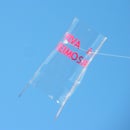Introduction: Dynamo Powered LEDs for Bike
This is a project that uses many recycled materials. We start by scraping a broken printer or scanner looking for a motor that can be used to generate energy. I made a back light with red LEDs but the same motor could power white LEDs for the front.
Please don't mind the fliptops with socks. This was made at the rural hacklab Nuvem - nuvem.tk
Step 1: The Printer
Open the printer with a screwdriver and a hex nut driver, and basically dismantle the whole thing. You might need to break some of the plastic pieces. In any printer there are many useful parts for DIY such as axes, sprockets, chains.
Step 2: The Motor
This is the kind of motor we're looking for. It's a stepper motor, used in printers because it allows fine control of the movement. You can recognize them easily as they have a connection for 4 to 6 wires. Sometime you'll find DC motors, which only have two wires. They can be used too, but the circuit is different.
Step 3: Some Parts
I picked this motor because it had a long axe which would be very appropriate to hook up to the wheel. I also used these two small blocks of wood (7cm x 4cm x 2cm or roughly 3 in x 2 in x 1 in). They'll be used to fix the LEDs. I also got some telephone wire, 6 red LEDs and 3 220 ohm resistors.
Step 4: The Circuit
Usually these motors have a pair number of outpus, but this one had 5, which was a bit odd. In end, almost anyway you connect the LEDs to the outputs will work.
One thing to keep in mind is that two given wires will have the current flowing in one direction in a moment, and in the opposite direction in the next moment. So you should connect two LEDs in parallel in opposite directions, in order to use the current coming from both ways. The resistor is there because I don't know how much voltage the motor gives out, and I was afraid that the LEDs would fry if I rode in high speed. You can connected the LEDs without them, but I don't know if they'll last much.
Since my motor has an odd wire, I tried connecting it to two LEDs, with these going to the other circuit, like the pic. It worked pretty well. I also attached what would be circuit with pair outputs.
I soldered the resistors close to the motor. The rest of the circuit was soldered and hidden between the blocks of wood.
Step 5: Reflection
I cut two small pieces of tetra pak to use as reflectors for the LEDs. They'll be glued to the wood behind the LED's
Step 6: Attaching the Light
I used nylon cable ties to close the two block with the LEDs in the middle, and another one to hook it to the bike.
Step 7: A Bit of Alcohol
The cork was essential to increase the friction between the wheel and the motor axe. I dug a small hole in it and screwed the axe in. Yes, it was Chilean wine.
Step 8: Hooking It All Up
This was actually the most difficult part. I used a combination of wires, cable ties and 3 rubber bands. The rubbers pull from the other side of the tire so there's enough pressure between tire and cork. Also, they can be unhooked when you don't want the dynamo working. In restrospect, the cable ties worked better because they're easier to adjust the distance. I don't have much advice besides that - I guess every bike will require a different solution.
And that's all!

Participated in the
UP! Contest











